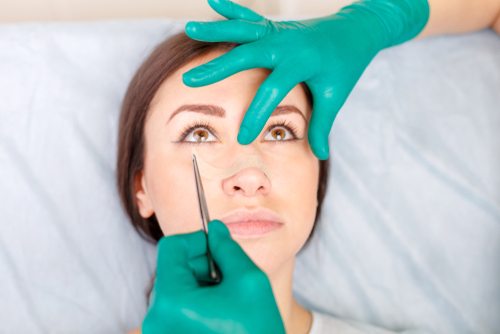Knowing When You Need a Revision Rhinoplasty

Rhinoplasty is a rewarding procedure that can transform the shape of the nose for a more aesthetically-pleasing appearance. However, rhinoplasty is also a difficult surgery that has the potential for undesirable outcomes. If you have had a rhinoplasty in the past and are dissatisfied with your results, then you could be a candidate for a revision rhinoplasty to improve your nose’s appearance and in some cases its function too.
Why Would Someone Need Revision Rhinoplasty?
There are a wide range of reasons why revision rhinoplasty may be necessary. While plastic surgeons are fully in charge of the surgery’s technical steps, the healing process cannot be controlled completely. An inexperienced or underqualified surgeon may also create results that are not in-line with the patient’s expectations. Potential issues for considering revision rhinoplasty can include:
- Too much bone or cartilage was removed
- Not enough bone or cartilage was removed
- The nose has healed improperly with scarring
- Injury or trauma to the nose has compromised results
- Primary rhinoplasty created asymmetries
- Cartilage grafts have become displaced
- Results do not match expectations
- Breathing has become obstructed
Candidates for Revision Rhinoplasty
If your primary rhinoplasty procedure has resulted in an undesirable outcome for any of the reasons listed above, you may be a good candidate for revision rhinoplasty. While rhinoplasty is primarily a cosmetic procedure, it can cause functional concerns if performed improperly. If too much cartilage is removed without establishing proper support, the internal structure of the nose can be obstructed and block the airways.
Whether your concern is of a functional or cosmetic nature, you may be a candidate for revision rhinoplasty if you are dissatisfied with your nose after a previous procedure. In most cases, you should wait at least one year before considering an additional procedure to ensure your nose has fully healed and swelling has completely subsided.
How Does It Work?
Revision rhinoplasty is different for every patient since no patient has the exact same concerns. If excess cartilage was removed and your breathing has become obstructed, cartilage grafts can be used to restore structure to your nose. Grafts can be taken from the nasal septum, parts of the ear and even the ribs. Revision rhinoplasty can improve the shape of your nasal tip and bridge and also fix asymmetries that resulted from prior surgery.
Small alterations may be made under twilight anesthesia while more extensive work will require general anesthesia. The procedure can take longer than primary rhinoplasty, especially in complex cases when cartilage grafts must be taken from the ear or rib cage.
Recovery is largely the same as for primary rhinoplasty although a small degree of swelling can linger for a longer period of time than for primary rhinoplasty. Patients typically experience temporary numbness of their nasal tip, swelling, and sometimes bruising. Patients return to work within 7-10 days and see their results improve over several months, with final results fully visible after 12-18 months.
Choosing a Qualified Surgeon
When it comes to a complicated procedure like revision rhinoplasty, choosing the right surgeon will make all the difference. Dr. Steven Daines is a double board-certified facial plastic surgeon who specializes in rhinoplasty and revision rhinoplasty. If you have previously undergone rhinoplasty and have continued concerns about the appearance or function of your nose, Dr. Daines may be able to help.
Revision rhinoplasty is a complex procedure. Make sure you choose a doctor with extensive experience in rhinoplasty. To learn more about revision rhinoplasty, give Daines Plastic Surgery a call at 949-397-6499 to schedule your consultation with Dr. Daines.



